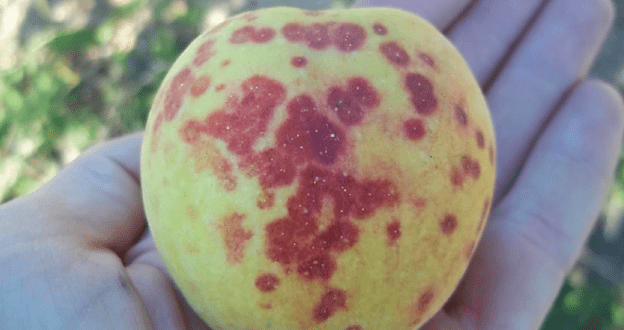

Jan 7, 2021Mating disruption studied for control of San Jose scale
San Jose scale has been traditionally controlled by pesticides and dormant oils, but increased pressure is giving researchers reason to look at mating disruption as an alternative control.
Michigan State University’s (MSU) Larry Gut, an entomologist, recently spoke on his research efforts at the Great Lakes Fruit, Vegetable & Farm Market EXPO. The trade show ran in a virtual format this year due to pandemic precautions.
San Jose scale is a tiny insect that sucks plant juices from twigs, branches and fruit. Uncontrolled, thousands of insects can render fruit unmarketable and even kill trees. It’s a pest of note in most U.S. tree fruit-growing regions.
“We’re seeing an increase in San Jose scale in various orchards across the state, we think, due to the general decline in use of dormant oil sprays, partly due to their increasing costs,” Gut said. The oils are applied during the dormant stage and work by suffocating or smothering the overwintering scale.
Broad-spectrum pesticides such as chlorpyriphos have historically been the most effective in controlling the tiny insects but new regulations have limited the use of such products. Gut said the insects are also known to develop resistance or tolerance to some insecticides. New chemical compounds haven’t shown the same degree of control.
It’s difficult for growers to prevent an infestation because the creatures are so tiny that it’s difficult to monitor them.
Growers “tend to only notice when the population is high and infesting the fruit, not just (when they’re) starting to get a foothold in the orchard,” Gut said.
The potential for mating disruption as a pest control of San Jose scale seems high.
“The females are wingless, which is an advantage,” Gut said. “The males are winged, but they only fly for a very short distance, perhaps a tree or two, and they have a very short lifespan – a few days. Also, the pheromone itself: The three pheromone components all seem to be equally attractive to San Jose scale, so you might not need the perfect blend.


“The dosage response study showed that lower dispenser density appeared effective, thus potentially reducing cost in that fewer dispensers required to achieve suppression,” he added later. Currently, though, “there are no commercially registered San Jose scale disruption products.”
The apple experiments took place at MSU’s Trevor Nichols Research Station, on four 0.2-acre plots near the town of Fennville in southwest Michigan. Two pheromone traps – a tent design baited with a pheromone lure – were placed in each plot. The study seemed to show a hybrid ability in that the pheromone dispensers were both competing with female insects (“competitive pheromones”) and also inhibiting the ability of some male insects to even respond to the pheromone (“non-competitive”).
“The male brain is actually fried and they can’t respond to the pheromone anymore,” Gut explained. “It looks like males would be taken out of the game non-competitively, quite a few of them, but others are still able to respond to the pheromone and you’re getting some competition” between the dispensers and female insects.
Trials appear promising
Management Educator Emily Pochubay and her team at the Northwest Michigan Horticultural Research Center (NWMHRC) in northwest Michigan’s Leelanau County were able to conduct two years of field trials with sweet cherries, Gut said.
“All of the pheromone treatments provided suppression of San Jose scale, including the one where pheromone was only applied the previous season,” Gut said. “So, it looks like they had enough carryover from the previous season to get a partial treatment of San Jose scale for part of the next year.”
Both sets of experiments seem promising for future use in the industry.
“This is really good, I think for San Jose scale,” Gut said. “Non-competitive (pheromone disruption) means you will get nearly 100% disruption … and it also means it’s not so density-dependent. And our dosage response curve suggests we may be able to go to even a lower rate … which makes this even more cost-effective at maybe $40 or $50 per acre.”
— Stephen Kloosterman, associate editor














